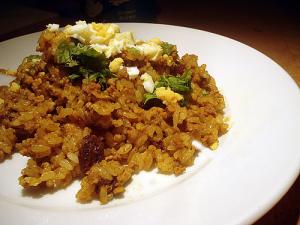
While the standard curry dish in Japan is a kind of curry stew served on plain rice, dry curry, which is a sort of fried rice with curry flavor, is almost as popular. And unlike the stew-type of Curry Rice it's very fast and easy to put together.
What makes it Japanese really is the use of _japonica_ (medium-grain) rice. Dry curry made with Japanese rice makes a great obento lunch, tasty at room temperature or warmed up in the microwave. The stick-together moist quality of the rice keeps it edible where a dryer stay-apart rice like basmati might taste too dry. Dry curry also has the mixture of sweet and savory, which appears quite a lot in Japanese food, especially the kind that comes from the Kanto (Tokyo-area) region where my family is from.
Filed under:
japanese rice yohshoku ground meat curry meat
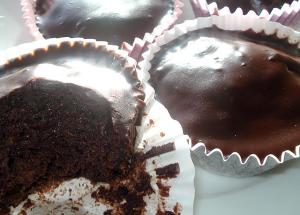
In the movie Chocolat, Juliette Binoche plays a somewhat mysterious woman who opens a chocolate shop in a small French village. She uses ancient Aztec spices in her chocolate confectioneries, which soon prove to have almost magical, often aphrodesiac, properties. While Chocolat is not in my top 5, or even 10, favorite food-theme movies (see here for that list), the idea of spiced chocolates has intrigued me ever since I saw it. One of my favorite chocolate bars is the Masala one made by Dolfin.
Making a spicy chocolate confection is a bit of a tricky affair though. You don't want the spices to overwhelm the chocolate - it should just form a sort of interesting background, yet provide a bit of a surprising bite and a warm, 'what is that?' quality.
These cupcakes have a rich but not too sweet bisquit (cake) base, with the warmth of curry powder and the bite of coarsely ground pepper. They are moistened with a teaspoon per cupcake of mocca liqueur, which increases its intensity and pushes it into the realm of an adult indulgence. The chocolate ganache has a pinch of cayenne pepper in it. The marriage is quite successful (or so the Tasters emphatically agreed). I'm not sure if they work at aphrodesiacs, but if your sweetheart is a chocoholic, you never know... They make a terrific Valentine's Day dessert or treat in any case.
Filed under:
chocolate dessert baking sweet cake cupcakes valentine
As I wrote in the Beef Curry recipe, I don't make my own curry powder. Lomo asked in the comments about the "secret" 15 to 20 spices that make up curry powder. After poking around a bit on Japanese web sites, I came up with this page that describes what goes into S & B curry powders, the most popular brand by far in Japan. It's an official S & B page, so should be accurate, though as you can see the percentage given have a pretty wide range. I guess it's because the actual formulas are 'secret'. In any case it gives a starting point for any experimentation I think.
I've also included a recipe for making garam masala. Note that I make no claims whatsoever that these are authentic mixes for Indian or other curries, but I'm talking here about Japanese curry.
Filed under:
japanese ingredients curry spices
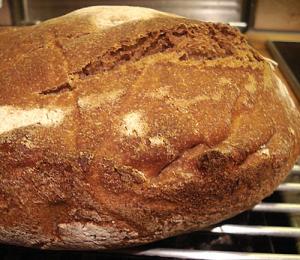 I've adapted the No Knead Bread method for making this bread as described here, for a bread that originally requires at least 20 minutes of kneading. It turns out a quite light, crispy-crust, delicious loaf.
I've adapted the No Knead Bread method for making this bread as described here, for a bread that originally requires at least 20 minutes of kneading. It turns out a quite light, crispy-crust, delicious loaf.
Filed under:
bread baking desem whole wheat

Japanese curry belongs to the group of typically Japanese foods that have origins in European cuisine, called yohshoku. Curry is tremendously popular in Japan - it's on the menu at just about every 'family' restaurant and department store restaurants, and there are curry-only restaurants as well as ones that specialize in high class yohshoku in general.
Japanese curry, called curry rice (or kareh raisu) since it's always served with rice, is not much like the curries from India, Thai or other places with better known curries around the world. The best way to describe it is probably to say it's like a English style stew with curry. (It's not at all like the curries you get in modern Britain, which are firmly in the Indian or Pakistani curry families.)
 If you've ever been to a Japanese grocery store, you've probably seen the blocks or bags of curry base taking up an inordinate amount of shelf space. Competition amongst curry base makers in Japan is fierce. The bases are pretty convenient to use, but these days I use them less and less, since I discovered that making curry properly from scratch is not that much more effort than making curry with a readymade curry base. Commercial curry bases contain things like sugar or corn syrup as ingredients, plus some of them use mystery fats (always check the ingredient lists). I add sweetness just via the vegetables, especially a huge mound of slowly sautéed onions.
If you've ever been to a Japanese grocery store, you've probably seen the blocks or bags of curry base taking up an inordinate amount of shelf space. Competition amongst curry base makers in Japan is fierce. The bases are pretty convenient to use, but these days I use them less and less, since I discovered that making curry properly from scratch is not that much more effort than making curry with a readymade curry base. Commercial curry bases contain things like sugar or corn syrup as ingredients, plus some of them use mystery fats (always check the ingredient lists). I add sweetness just via the vegetables, especially a huge mound of slowly sautéed onions.
Either way, to get the most flavorful curry takes a long time. This is definitely a slow-cook meal.
This recipe for beef curry can be adapted to other kinds of meat, or to vegetarian options too. I've included instructions for using a store bought curry base as well as making your own curry roux base.
Filed under:
japanese rice yohshoku favorites beef slowcook curry
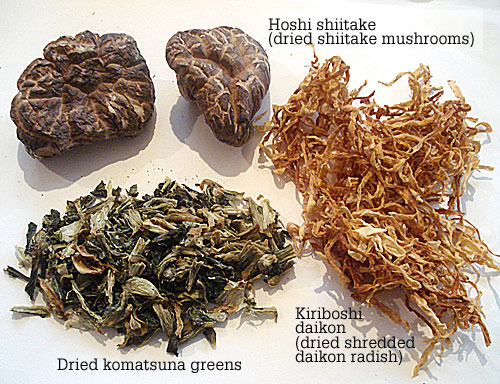
At some time in the past. all our ancestors must have relied on drying as a means of preserving food, especially vegetables. Unfortunately most of these have disappeared from our tables in the West except for grains and legumes. (See note at the end of this article for some exceptions.)
Filed under:
japanese vegetables ingredients mushrooms
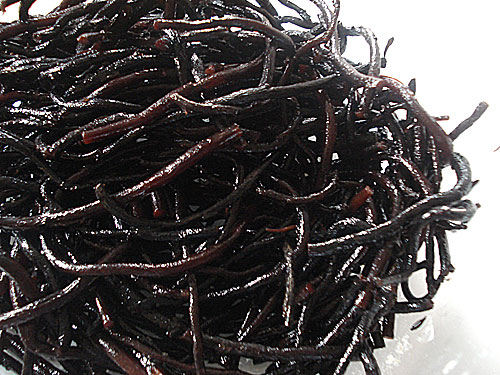
Next up in the OJFTMHYLW list is seaweed. But..why not call it sea vegetables? Weed sounds so unappetizing, so unwanted. Yet, seaweed is a terrific food.
Filed under:
japanese lighter weightloss ingredients seaweed
As part of my weight loss efforts, not to mention generally trying to 'eat better', flirting with 'makurobi' (the Japanese word for macrobiotic, and also meaning a 'hipper' version of macrobiotic cooking) and such, I've been cooking more brown rice as opposed to polished white rice. Fortunately my rice cooker has a gen-mai (brown rice) cooking setting.
Filed under:
basics japanese rice
Pages